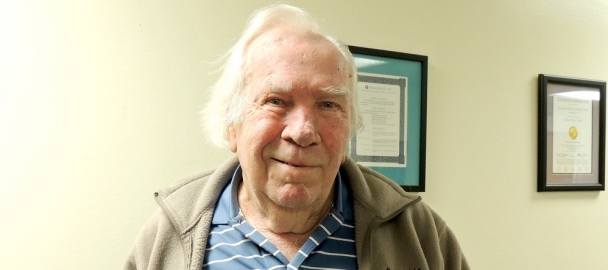
In 2013, Bill had a broken vertebrae and had undergone a kyphoplasty – an elective surgery designed to help patients suffering from painful vertebral compression fractures – about five days later he experienced a stroke. He was taken to the emergency department (ED) at Long Beach Medical Center and was later admitted. While he was recovering, he worked with a physical therapist to strengthen his muscles that were affected by the stroke.
A few years after Bill’s first stroke, he was golfing, fishing and hunting regularly. In 2016, his world was flipped upside down again. Bill suffered a second stroke. It also was discovered that he had an abdominal aortic aneurysm – an enlarged area in the lower part of the aorta, the major blood vessel that supplies blood to the body.
The aneurysm was large enough that there was a risk of it rupturing, but Bill wasn’t going to let that get the best of him. He enlisted the help of a trusted friend and colleague from his time as a Chief Financial Officer at a local Southern California hospital – Rodney White, M.D., medical director, Vascular Surgery Program, MemorialCare Heart & Vascular Institute, Long Beach Medical Center.
“A good rule of thumb for medical professionals is to never treat friends or family,” says Dr. White. “But, when Bill asked for my help, I couldn’t say no.”
Bill met with Dr. White to determine how to prevent the aneurysm from rupturing. After discussing several options, Dr. White and Bill felt confident that placing an endovascular stent graft was the best plan. The stent was placed inside his abdominal aorta to help protect and prevent the aneurysm from rupturing. Ironically, the stent that was best suited for Bill’s aneurysm was one that he oversaw the regulatory portion of the clinical study.
Known as a leader in the prevention, diagnosis, treatment, rehabilitation and research of cardiovascular disease, the cardiac care team at the MemorialCare Heart & Vascular Institute at Long Beach Medical Center offers the full spectrum of endovascular care, including minimally invasive techniques to treat aortic aneurysms.
Even though this was Bill’s second hospitalization for a stroke, it was his first time staying with Long Beach Medical Center for cardiac surgery.
“I have visited and been a patient at Long Beach Medical Center before,” says Bill. “The care at Long Beach Medical Center is fantastic and the care team put all my nerves at ease.”
Long Beach Medical Center’s reputation for being one of the best hospitals in Southern California meant a lot to Bill and knowing that he was at a renowned hospital made his stay more comfortable.
While Bill was in the hospital recovering from his second stroke and cardiac surgery, he participated in speech, physical and occupational therapy at Long Beach Medical Center. During Bill’s sessions with his therapists, he strengthened his communication, his functional mobility skills for daily large motion activities and his performance in daily tasks, like bathing and dressing.
Since returning home, Bill is enjoying his time with his wife and routinely participates in outpatient rehabilitation therapy at Long Beach Medical Center. He even attends a balance class every week to help improve balance, reduce fall risks and increase functional mobility.
Even though Bill is not as active as he used to be, he is extremely happy with the progress he’s made thanks to his care teams at Long Beach Medical Center.